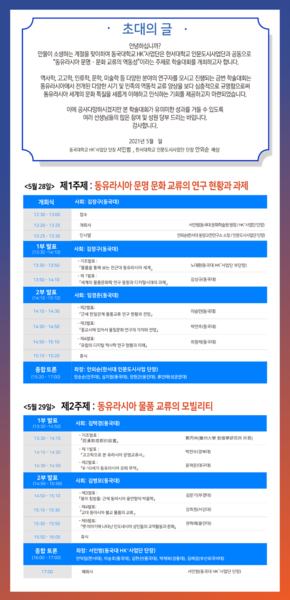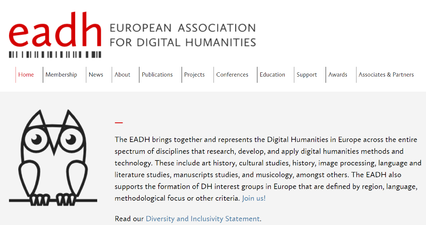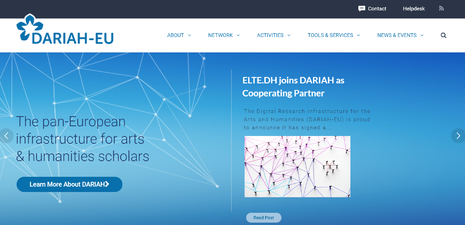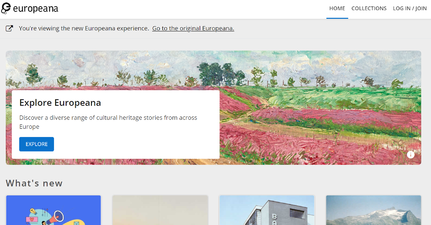"유럽의 디지털 인문학"의 두 판 사이의 차이
(→역사 디지털 인문학) |
|||
| 24번째 줄: | 24번째 줄: | ||
Two European Research Infrastructures Research infrastructures offer resources and services to the scientific community. They stimulate international, cross-disciplinary collaboration, promote the use of common methods and standards, and educate new generations of scholars. In Europe, the European Strategy Forum on Research Infrastructures (ESFRI) recognises over fifty different research infrastructures covering a wide range of academic disciplines, including biomedical science, astrophysics, heritage science, and many others. In this section we will focus on two such organisations recognised by ESFRI as established ‘landmarks’ serving the humanities and social sciences: the Common Language and Technology Infrastructure (or CLARIN, https://www.clarin.eu) and the Digital Research Infrastructure for the Arts and Humanities (or DARIAH, https://www.dariah.eu/) (ESFRI, 2018: 12). CLARIN and DARIAH have distinct and complementary objectives underpinning their infrastructure models. CLARIN’s mission is to create and maintain an infrastructure to support the sharing, use and sustainability of language data and tools for research in the humanities and social sciences. DARIAH aims to enhance and support digitally-enabled research across the arts and humanities. Both CLARIN and DARIAH are European Research Infrastructure Consortia (or ERICs), a form of legal entity created in order to allow pan-European initiatives like CLARIN and DARIAH to be formalised on a non-economic basis. (EC, 2019) They are independent organisations, with their own governing bodies, primarily funded through the fees paid by their respective member-countries. As noted above, over the last decades vast numbers of digital collections and tools have been created for DH research. While this abundance enables new ways of doing research, it also 1 For a general introduction to research infrastructures for the humanities, see: http://training.parthenos-project.eu/sample-page/intro-to-ri/ . 4 brings a number of challenges. How can all these data be stored in a sustainable way? How can researchers find the collections and tools relevant for their research? Research infrastructures offer solutions for these challenges by hosting data repositories to make collections and tools sustainable (Edmond, 2015) and providing platforms for finding and sharing data. To mention but two examples, CLARIN recently launched an initiative to provide user-friendly overviews of so-called Resource families throughout Europe, such as parliamentary records, newspaper corpora, corpora of spoken language, second language learner corpora, and several others. Resource families are selected based on their availability in multiple languages and their relevance for a wide range of disciplines and methodological approaches and therefore offer lots of potential for cross-disciplinary and cross-border research. The overview page for each resource family2 gives information on the structure of the corpus, licenses and download links (Fišer et al., 2018). DARIAH is currently constructing an open Marketplace for the humanities and social sciences, which will grow into a rich environment for humanities researchers to share data, tools and services (Edmond et al., forthcoming). These services stimulate the reuse of existing data and tools, which not only saves time and money but also enables researchers to study phenomena regardless of their place of residence. To make it easier for researchers to use and combine different datasets, CLARIN and DARIAH have adopted common standards for (meta)data. Both research infrastructures are also committed to promoting and exemplifying the movement toward making research data Findable, Accessible, Interoperable and Reusable (FAIR) (De Jong et al., 2018). Facilitating opportunities for cross-disciplinary and cross-border collaboration is another key feature of research infrastructures. CLARIN and DARIAH actively stimulate this kind of collaboration by offering physical and virtual platforms where researchers from various countries and disciplines meet each other. Both research infrastructures organise conferences, workshops and other events to exchange best practices, forge collaborations and enhance the infrastructure. Within DARIAH, a number of working groups have been established dedicated to strategic and emerging areas such as Artificial Intelligence and Music, GeoHumanities, and Women Writers in History. These working groups form a vital link between the infrastructure and the community of users (Romary and Edmond, 2019). CLARIN maintains a Knowledge Sharing Infrastructure, with knowledge centres specialised in Speech Analysis, Data Management, Digitisation, and many other fields of expertise. In short, CLARIN and DARIAH support DH by offering access to data collections and tools and the means to share them by providing opportunities for both collaboration and individual development. This whole endeavour relies upon the contributions, in terms of research, development, curation and teaching, carried out within the member-countries and universities, research institutes and GLAM organisations involved in CLARIN and DARIAH, yet the scientific impact of research infrastructures is larger than the sum of their parts. Their supra-national scale allows researchers to access knowledge and best practice on topics like common standards, cross-border collaboration and comparative research agendas. CLARIN and DARIAH provide an international platform for research, collaboration and teaching in DH, but in this last element it differentiates itself from other players in a diverse field by providing distinctly macro-level, 2 See this webpage for the relevant links: https://www.clarin.eu/resource-families 5 infrastructural added value. To allow the DH to continue to flourish, it is crucial to educate new generations of students and researchers, but education in DH is not limited to transmitting concrete and practical skills related to data architecture, analytics, and programming, it also includes learning to think critically about these computational methods (Murphy and Smith, 2017) and apply them within the often messy contexts of humanities datasets. In order to support this transition as something distinct from either traditional humanities, librarianship or computer science training, CLARIN and DARIAH have developed a number of initiatives to support teaching in DH, which will be explained in more detail below. | Two European Research Infrastructures Research infrastructures offer resources and services to the scientific community. They stimulate international, cross-disciplinary collaboration, promote the use of common methods and standards, and educate new generations of scholars. In Europe, the European Strategy Forum on Research Infrastructures (ESFRI) recognises over fifty different research infrastructures covering a wide range of academic disciplines, including biomedical science, astrophysics, heritage science, and many others. In this section we will focus on two such organisations recognised by ESFRI as established ‘landmarks’ serving the humanities and social sciences: the Common Language and Technology Infrastructure (or CLARIN, https://www.clarin.eu) and the Digital Research Infrastructure for the Arts and Humanities (or DARIAH, https://www.dariah.eu/) (ESFRI, 2018: 12). CLARIN and DARIAH have distinct and complementary objectives underpinning their infrastructure models. CLARIN’s mission is to create and maintain an infrastructure to support the sharing, use and sustainability of language data and tools for research in the humanities and social sciences. DARIAH aims to enhance and support digitally-enabled research across the arts and humanities. Both CLARIN and DARIAH are European Research Infrastructure Consortia (or ERICs), a form of legal entity created in order to allow pan-European initiatives like CLARIN and DARIAH to be formalised on a non-economic basis. (EC, 2019) They are independent organisations, with their own governing bodies, primarily funded through the fees paid by their respective member-countries. As noted above, over the last decades vast numbers of digital collections and tools have been created for DH research. While this abundance enables new ways of doing research, it also 1 For a general introduction to research infrastructures for the humanities, see: http://training.parthenos-project.eu/sample-page/intro-to-ri/ . 4 brings a number of challenges. How can all these data be stored in a sustainable way? How can researchers find the collections and tools relevant for their research? Research infrastructures offer solutions for these challenges by hosting data repositories to make collections and tools sustainable (Edmond, 2015) and providing platforms for finding and sharing data. To mention but two examples, CLARIN recently launched an initiative to provide user-friendly overviews of so-called Resource families throughout Europe, such as parliamentary records, newspaper corpora, corpora of spoken language, second language learner corpora, and several others. Resource families are selected based on their availability in multiple languages and their relevance for a wide range of disciplines and methodological approaches and therefore offer lots of potential for cross-disciplinary and cross-border research. The overview page for each resource family2 gives information on the structure of the corpus, licenses and download links (Fišer et al., 2018). DARIAH is currently constructing an open Marketplace for the humanities and social sciences, which will grow into a rich environment for humanities researchers to share data, tools and services (Edmond et al., forthcoming). These services stimulate the reuse of existing data and tools, which not only saves time and money but also enables researchers to study phenomena regardless of their place of residence. To make it easier for researchers to use and combine different datasets, CLARIN and DARIAH have adopted common standards for (meta)data. Both research infrastructures are also committed to promoting and exemplifying the movement toward making research data Findable, Accessible, Interoperable and Reusable (FAIR) (De Jong et al., 2018). Facilitating opportunities for cross-disciplinary and cross-border collaboration is another key feature of research infrastructures. CLARIN and DARIAH actively stimulate this kind of collaboration by offering physical and virtual platforms where researchers from various countries and disciplines meet each other. Both research infrastructures organise conferences, workshops and other events to exchange best practices, forge collaborations and enhance the infrastructure. Within DARIAH, a number of working groups have been established dedicated to strategic and emerging areas such as Artificial Intelligence and Music, GeoHumanities, and Women Writers in History. These working groups form a vital link between the infrastructure and the community of users (Romary and Edmond, 2019). CLARIN maintains a Knowledge Sharing Infrastructure, with knowledge centres specialised in Speech Analysis, Data Management, Digitisation, and many other fields of expertise. In short, CLARIN and DARIAH support DH by offering access to data collections and tools and the means to share them by providing opportunities for both collaboration and individual development. This whole endeavour relies upon the contributions, in terms of research, development, curation and teaching, carried out within the member-countries and universities, research institutes and GLAM organisations involved in CLARIN and DARIAH, yet the scientific impact of research infrastructures is larger than the sum of their parts. Their supra-national scale allows researchers to access knowledge and best practice on topics like common standards, cross-border collaboration and comparative research agendas. CLARIN and DARIAH provide an international platform for research, collaboration and teaching in DH, but in this last element it differentiates itself from other players in a diverse field by providing distinctly macro-level, 2 See this webpage for the relevant links: https://www.clarin.eu/resource-families 5 infrastructural added value. To allow the DH to continue to flourish, it is crucial to educate new generations of students and researchers, but education in DH is not limited to transmitting concrete and practical skills related to data architecture, analytics, and programming, it also includes learning to think critically about these computational methods (Murphy and Smith, 2017) and apply them within the often messy contexts of humanities datasets. In order to support this transition as something distinct from either traditional humanities, librarianship or computer science training, CLARIN and DARIAH have developed a number of initiatives to support teaching in DH, which will be explained in more detail below. | ||
| − | === | + | ===디지털 역사학=== |
===주요 프로젝트=== | ===주요 프로젝트=== | ||
2021년 5월 11일 (화) 14:34 판
서론
유럽에서는 이미 오래전부터 디지털 인문학적 방법이 하나의 학문영역으로 자리매김했다. 유럽에서의 디지털 인문학적 방법은 문학 분야와 역사학계를 필두로 점차 확산되었다. 유럽은 시공간적으로 공통되는 커다란 학문적 소스를 매개로 학문적 진화를 도모하고 있으므로 디지털 인문학이 맺어온 결과와 그 연구 집단의 분포를 국가별로 나누는 것은 크게 의미가 없다. 우리보다 먼저 시작한 디지털 인문학이 이들 유럽 국가 집단에 끼치는 영향을 살피고 디지털 인문학을 움직이게 하는 힘을 파악하여 우리가 취해야 할 학문의 자세를 재정립할 수 있는 인사이트를 찾아보는 것이 이번 발표의 핵심이다.
유럽에서의 디지털 인문학
디지털 인문학의 시작을 연 사람들 중에 한 명은 이탈리아 예수회의 로베르토 부사(Roberto Busa) 신부다. 그로부터 인문전산학(Humanities Computing)이라는 새로운 방법론이 나타나게 되었다. 1998년 부사는 토마스 아퀴나스와 중세 저자들의 라틴어 저작물을 IBM사의 기술지원을 받아 라틴어 전문 색인을 전자적인 방법으로 편찬했다. 그의 업적을 기리기 위해서 디지털인문학회연합(ADHO: Alliance of Digital Humanities Organization)은 로베르토 부사상을 제정했다.
1973년에는 문학언어컴퓨팅협회(ALLC)가 설립되었는데 지금의 디지털인문학유럽협회의(EADH) 전신이다. 이즈음 언어학과 문학에서부터 점차 역사, 예술사, 음악, 필사본 연구 등으로 컴퓨터를 이용한 연구의 관심이 확대되기 시작했다. 유럽의 디지털 인문학의 양대 축은 CLARIN과 DARIAH다. 그리고 europeana가 그 대열에 합류했다.
Two European Research Infrastructures Research infrastructures offer resources and services to the scientific community. They stimulate international, cross-disciplinary collaboration, promote the use of common methods and standards, and educate new generations of scholars. In Europe, the European Strategy Forum on Research Infrastructures (ESFRI) recognises over fifty different research infrastructures covering a wide range of academic disciplines, including biomedical science, astrophysics, heritage science, and many others. In this section we will focus on two such organisations recognised by ESFRI as established ‘landmarks’ serving the humanities and social sciences: the Common Language and Technology Infrastructure (or CLARIN, https://www.clarin.eu) and the Digital Research Infrastructure for the Arts and Humanities (or DARIAH, https://www.dariah.eu/) (ESFRI, 2018: 12). CLARIN and DARIAH have distinct and complementary objectives underpinning their infrastructure models. CLARIN’s mission is to create and maintain an infrastructure to support the sharing, use and sustainability of language data and tools for research in the humanities and social sciences. DARIAH aims to enhance and support digitally-enabled research across the arts and humanities. Both CLARIN and DARIAH are European Research Infrastructure Consortia (or ERICs), a form of legal entity created in order to allow pan-European initiatives like CLARIN and DARIAH to be formalised on a non-economic basis. (EC, 2019) They are independent organisations, with their own governing bodies, primarily funded through the fees paid by their respective member-countries. As noted above, over the last decades vast numbers of digital collections and tools have been created for DH research. While this abundance enables new ways of doing research, it also 1 For a general introduction to research infrastructures for the humanities, see: http://training.parthenos-project.eu/sample-page/intro-to-ri/ . 4 brings a number of challenges. How can all these data be stored in a sustainable way? How can researchers find the collections and tools relevant for their research? Research infrastructures offer solutions for these challenges by hosting data repositories to make collections and tools sustainable (Edmond, 2015) and providing platforms for finding and sharing data. To mention but two examples, CLARIN recently launched an initiative to provide user-friendly overviews of so-called Resource families throughout Europe, such as parliamentary records, newspaper corpora, corpora of spoken language, second language learner corpora, and several others. Resource families are selected based on their availability in multiple languages and their relevance for a wide range of disciplines and methodological approaches and therefore offer lots of potential for cross-disciplinary and cross-border research. The overview page for each resource family2 gives information on the structure of the corpus, licenses and download links (Fišer et al., 2018). DARIAH is currently constructing an open Marketplace for the humanities and social sciences, which will grow into a rich environment for humanities researchers to share data, tools and services (Edmond et al., forthcoming). These services stimulate the reuse of existing data and tools, which not only saves time and money but also enables researchers to study phenomena regardless of their place of residence. To make it easier for researchers to use and combine different datasets, CLARIN and DARIAH have adopted common standards for (meta)data. Both research infrastructures are also committed to promoting and exemplifying the movement toward making research data Findable, Accessible, Interoperable and Reusable (FAIR) (De Jong et al., 2018). Facilitating opportunities for cross-disciplinary and cross-border collaboration is another key feature of research infrastructures. CLARIN and DARIAH actively stimulate this kind of collaboration by offering physical and virtual platforms where researchers from various countries and disciplines meet each other. Both research infrastructures organise conferences, workshops and other events to exchange best practices, forge collaborations and enhance the infrastructure. Within DARIAH, a number of working groups have been established dedicated to strategic and emerging areas such as Artificial Intelligence and Music, GeoHumanities, and Women Writers in History. These working groups form a vital link between the infrastructure and the community of users (Romary and Edmond, 2019). CLARIN maintains a Knowledge Sharing Infrastructure, with knowledge centres specialised in Speech Analysis, Data Management, Digitisation, and many other fields of expertise. In short, CLARIN and DARIAH support DH by offering access to data collections and tools and the means to share them by providing opportunities for both collaboration and individual development. This whole endeavour relies upon the contributions, in terms of research, development, curation and teaching, carried out within the member-countries and universities, research institutes and GLAM organisations involved in CLARIN and DARIAH, yet the scientific impact of research infrastructures is larger than the sum of their parts. Their supra-national scale allows researchers to access knowledge and best practice on topics like common standards, cross-border collaboration and comparative research agendas. CLARIN and DARIAH provide an international platform for research, collaboration and teaching in DH, but in this last element it differentiates itself from other players in a diverse field by providing distinctly macro-level, 2 See this webpage for the relevant links: https://www.clarin.eu/resource-families 5 infrastructural added value. To allow the DH to continue to flourish, it is crucial to educate new generations of students and researchers, but education in DH is not limited to transmitting concrete and practical skills related to data architecture, analytics, and programming, it also includes learning to think critically about these computational methods (Murphy and Smith, 2017) and apply them within the often messy contexts of humanities datasets. In order to support this transition as something distinct from either traditional humanities, librarianship or computer science training, CLARIN and DARIAH have developed a number of initiatives to support teaching in DH, which will be explained in more detail below.
디지털 역사학
주요 프로젝트






